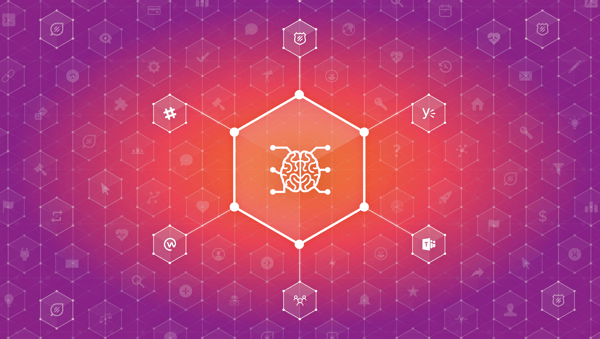How AI is Protecting Company Culture on Collaboration Platforms
by Jason Morgan
The emergence of social media in the last decade has led to several profound changes in the way we work, collaborate, and interact with one another. Recently, our personal social media networks have evolved into professional collaboration networks. The information silos that dominated businesses and created barriers between business units have come crumbling down as more companies adopt collaboration tools such as Slack, Yammer, and Workplace by Facebook.

In the world we live in today, company fortunes are created and destroyed by hashtags. The #MeToo movement is a perfect example of how rapidly these networks can unsettle the status quo. Social networks have become a tremendously disruptive force, and C-suite executives may be wary of deploying the professional versions of these platforms in the form of collaboration tools, such as Yammer, Workplace by Facebook, and Slack, at their companies. After all, these tools can appear to be black boxes, providing conduits for harassment and bad behavior. Sometimes it may seem that the risks introduced by these tools may outweigh the numerous benefits.
However, instead of limiting communication in the hopes of avoiding the cable news cycle, companies should be seeking to expand it. Communication via email, social networks, and other methods help expose problems as they emerge. Bad behavior thrives in darkness. When it is exposed, it is diminished. An open communication environment allows for the problems to be solved in real-time, for issues to be discussed openly, and for information to be passed seamlessly.
As with any human endeavor, problems can and will arise. This is where technology – and rapid advancements in machine learning, in particular – can play a key role in helping to understand and manage collaboration. While there are various tools available that provide a bird's eye view into collaboration, innovative applications of Natural Language Processing (NLP) and Social Network Analysis (SNA) can provide much deeper insight.
NLP allows community managers to dig into the what and why of collaboration. At the most basic level, NLP tools provide the ability to pick out key words or phrases. This is useful in those instances where management knows what they are looking for; like trying to identify prohibited discussion around Merger and Acquisitions activity, for example. But in the last decade, NLP has moved well beyond formulaic keyword searches. Modern neural networks and word-embedding models provide methods of categorizing messages into associated topics, even in the absence of common keywords and phrases, as well as judge the sentiment of messages and identify conversations that may be inappropriate for a work setting.
These tools can be incredibly useful for managing corporate collaboration networks. Imagine being able to track, in real-time, incidents of harassing or inflammatory speech within a network. Management could take immediate action to limit such toxic behavior before it drags down morale and productivity. How valuable would such a tool have been for executives at a company that was tarnished by the #MeToo movement simply because it’s executives were unaware of the issues their female employees were experiencing.
In another example, one can imagine the desire of an HR department to track the sentiment of employees towards a new or proposed change in policy. As we all know, corporate policies are often complicated. Small changes frequently have unforeseen consequences. Employees are often the first to point out problems with policies, and by tracking reactions to policies on the corporate network, management could more quickly address any misunderstandings.
While NLP tells us what people are communicating about, social network analysis (SNA) helps us understand who communicates with whom in a collaboration network. In other words, SNA allows us to map the patterns of collaboration to identify variation in activity across an organization over time. At a minimum, such mappings are useful in planning community development strategies to identify "dead zones" with little adoption as well as identifying the "hotspots" in usage.
Beyond this use case, SNA can also be used to define metrics for success in other domains. For instance, the overall success of a merger or acquisition may hinge on employees of one company being integrated quickly and efficiently into the culture and business processes of the acquiring company. SNA can be used to put concrete metrics on progress. If collaboration between employees of the separate companies does not materialize quickly enough, management can shift strategies to remedy the issue.
Additionally, SNA can be used to identify influential members of an organization. This could be used to estimate the impact of attrition of individuals on communication.
NLP and SNA are powerful tools on their own, but combined they become a game-changer. Not only can patterns of communication be mapped out, the sentiment or topic of conversations can be overlaid in ways that highlight particular problem areas. Notwithstanding some of the recent stories out of Silicon Valley, harassment or other types of toxic behavior are typically isolated in nature – small groups of employees often partake in poor behavior amongst themselves. With SNA and NLP, such problem areas become readily apparent. In this way, the culture of a company can be mapped out across departments.
With the ability to zero in on toxic members, conversations, and behavior, organizations can offer a safeguard for employees at all levels. Aware's platform offers this visibility and insight. With our platform, organizations have the ability to keep a direct pulse on the overall sentiment of employees, set configurable policies based on what is important to the company and ensure compliance both from a regulatory and HR perspective. We do more than just monitor the content and behavior of employees, we take it a step further and help protect and enhance company culture – and of course, we use both SNA and NLP to do so.
 Jason Morgan leads Aware’s behavioral intelligence team in implementing the full data science pipeline, from data acquisition and warehousing through model deployment, with a heavy focus on developing predictive natural language and network models for enterprise social collaboration. Jason earned his PhD in political methodology from The Ohio State University in 2015, where he retains a Visiting Scholar position. His research interests include applications of inferential network and latent variable models, computational statistics, and Bayesian modeling.
Jason Morgan leads Aware’s behavioral intelligence team in implementing the full data science pipeline, from data acquisition and warehousing through model deployment, with a heavy focus on developing predictive natural language and network models for enterprise social collaboration. Jason earned his PhD in political methodology from The Ohio State University in 2015, where he retains a Visiting Scholar position. His research interests include applications of inferential network and latent variable models, computational statistics, and Bayesian modeling.
Don't miss Jason's upcoming session at Startup Week Columbus 2018. He will be explaining how to implement artificial intelligence and machine learning into your product--in plain english.







